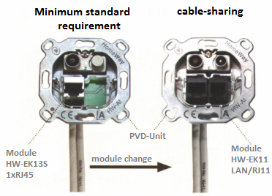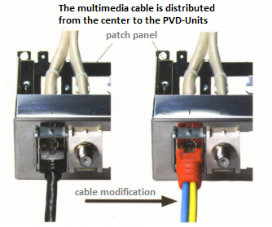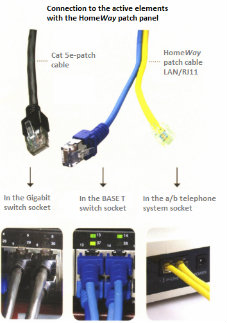HomeWay cable-sharing
Cable Sharing
The new EN 50173-4 standard defines the wall output MATO including 1xsignal relay output (IEC or F) AND 1xtelecommunication output (RJ45).
And of course HomeWay fulfills these standards and provides even more!
The HomeWay date cable network consists of 8 insulated cables. The RJ45 output has 8 pins. All of 8 pins are used to transfer Gigabit through Ethernet (1000 Base-T). The telephone and LAN10/100Mbit(10/100 Base-T) services are transferred through the 4 pins. The other 4 pins are not used. Now you can use the Gigabit Ethernet only under demanding circumstances and most of the devices have the potentials to transfer only up to 100MBit, the unused insulated cables can be used for other devices.
This means that 4 of the cables can be used in a specific application and the other 4 can be used in another at the same time. This is the cable sharing. In this way 50% less cable is needed and the data cable can be used in two applications at the same time.
This HomeWay patent offers a multi-tasking module with 8 full-sized lines in all 8 pins which can be used for Gigabit Ethernet (HW-EK13S). Our customers usually use double modules like HW-EK11 LAN/RJ11 for two telecommunication services from one output at the same time.
HomeWay offers a variety of double modules for cable sharing so as the LAN,ISDN, RJ11 combinations work properly.
The cable has to be connected not only to the PVD-Unit (including the removable modules) but also to the patch panel to respective customer device. So the connection between the specific number on the patch panel and the device with the respective system patch cable work properly.
For every removable module which is installed on the PVD-Unit there is a respective signal patch cable.
The different colors of the patch cables represent different services or applications. The blue cable stands for LAN (10/100 Base-T), the green one for ISDN and the yellow one for the analog telephone.


